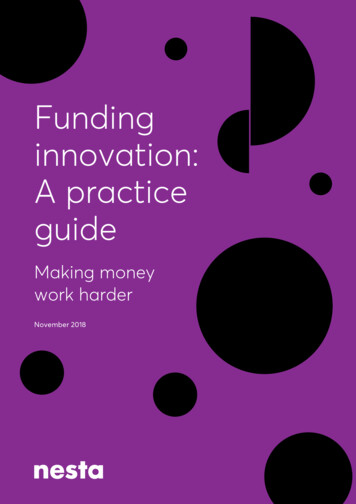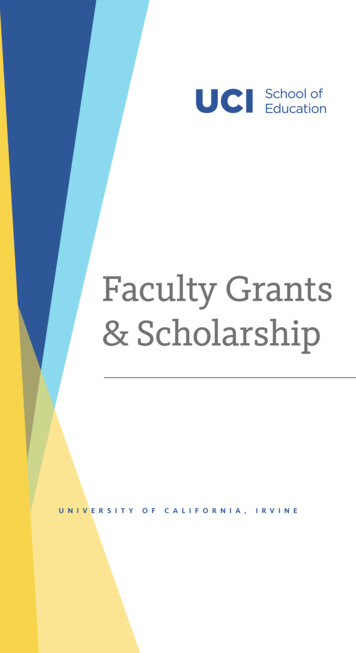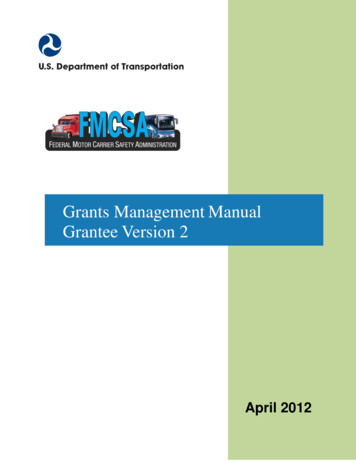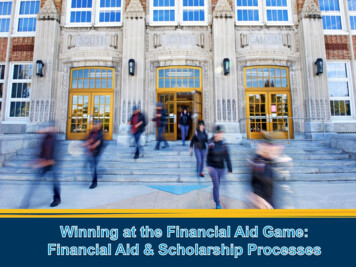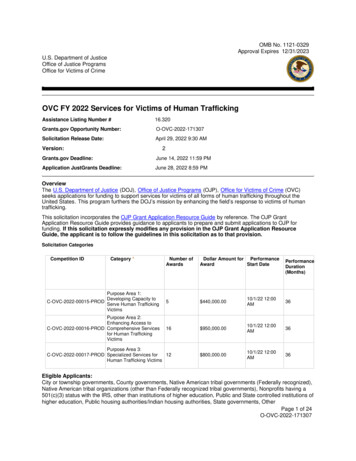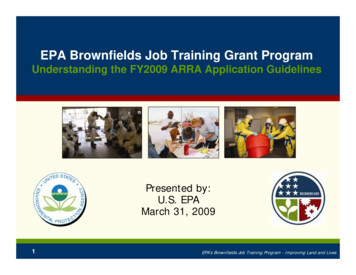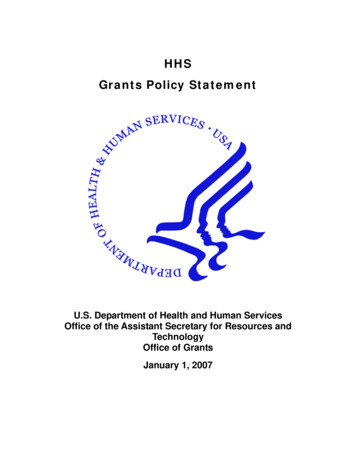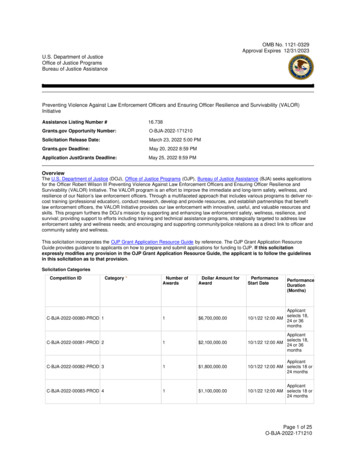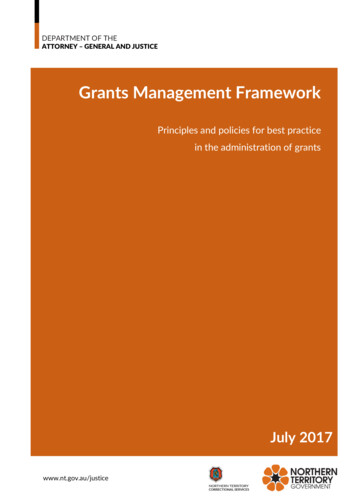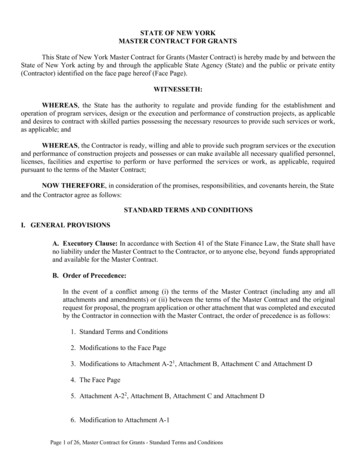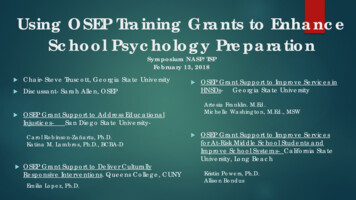
Transcription
Using OSEP Training Grants to EnhanceSchool Psychology PreparationSymposium NASP/TSPFebruary 13, 2018 Chair- Steve Truscott, Georgia State University Discussant- Sarah Allen, OSEP OSEP Grant Support to Deliver CulturallyResponsive Interventions. Queens College, CUNYEmilia Lopez, Ph.D.OSEP Grant Support to Improve Services inHNSDs- Georgia State UniversityArtesia Franklin. M.Ed.Michelle Washington, M.Ed., MSWOSEP Grant Support to Address EducationalInjusticesSan Diego State UniversityCarol Robinson-Zañartu, Ph.D.Katina M. Lambros, Ph.D., BCBA-D OSEP Grant Support to Improve Servicesfor At-Risk Middle School Students andImprove School Systems- California StateUniversity, Long BeachKristin Powers, Ph.D.Allison Bondus
USING OSEP GRANT SUPPORT TOHELP PREPARE SCHOOLPSYCHOLOGISTS TOADDRESSEDUCATIONAL INJUSTICESKATINA LAMBROS ORTEGA CAROL ROBINSON- ZAÑARTUSAN DIEGO STATE UNIVERSITY
WHAT ARETHE SOCIAL JUSTICE/INJUSTICE ISSUES? Under/over-represented in special education Misidentified with disabilities Under-served in general education Lack of culturally appropriate interventions Disproportionate dropout/pushout rates
SDSU OSEP GRANTS OVER THE YEARS A long and rich history of DOE Office of Special Education Projects (OSEP) supporteddozens of unique projects at San Diego State University to prepare school psychologiststo address these educational inequities – unique characteristics and needs of twoprojects/groups will be shared Data-gathering tools useful to the project management, illustrate the use of progressmonitored interventions, competency and goal attainments scales, and effect sizecalculations to support outcomes for the preparation of school psychologists and for theschool sites they serve during their training programs.
PROJECT CI2ELO: COLLABORATIVE INTERVENTIONSTO IMPROVE ENGLISH LEARNERS’ OUTCOMES Transdisciplinary learning and collaboration between school psychologistsand speech-language pathologists to meet the needs of English/DualLanguage Learners Partnership with local school district to support literacy interventions in1st & 2nd grade classrooms and increase parent outreach Intensive Seminars,Yearly Institutes, Project Retreats, ConferenceAttendance focused on understanding characteristics of and learningneeds of multilingual children
THE NATIVE AMERICAN AND INDIGENOUSSCHOLARS COLLABORATIVE (NAISC)Authentic and Effective School & Community Engagement: Partnerships with tribal community:parents,leaders and elders Partnership with school district serving Native youth:Specialized practicaKnowledge and Skill Building Seminar weekly: built ity Annual Institutes – Summer and winter:enhance depth in cultural insights,methods,culturally responsivepedagogyDissemination:Local,state and national presentations engage scholars in dissemination,using oraltraditions which are culturally consistent with traditional learning and teaching
USING CULTURALLY RELEVANT PEDAGOGY
USING CULTURALLY RELEVANT PEDAGOGY Migrant Education Family Biliteracy Program:Building the Foundation for Biliteracy.FernandoRodríguez-Valls,Ph.D.State Director,Migrant Education Program, RTI for ELLs: Instruction & Intervention. Dr. Julie Esparza Brown English Learners Learning to Read English. “101” Dr. Fernando Rodriguez-Valls Language-Based Interventions for ELL/Bilingual Students: A CulturallyResponsive Perspective. Dr. ElizabethPeña
DEVELOPING COMPETENCE: NATIVE SCHOLARSAUGMENTING SCHOOL PSYCHOLOGY & COUNSELING PROGRAM COMPETENCIESA R E A 1. Legal a n d Ethical Issues with N A Y outhTitle VIIJohnson O-Malley ActTribal T A N FEthical practice with N A populationsSovereignty, tribal l a wI C W AA R E A 2. Educational a n d Cultural History a n d PolicyIndian history a n d implications for educationLocal cultural/tribal specific history a n d implicationsTribal education s y s t e m s (BIE, Tribal Schools a n d Colleges)T raditional k n o w l e d g e a n d its relations hip t o l e a r n i n gHistories of indigenous M e x i c a n youth/families a n d implicationsA R E A 3. Culturally Appropriate As s essment with N A a n d IndigenousyouthSufficient rang e of appropriate toolsConsider language development a n d acculturation in as sessmentLocal/cultural n o r m sBias issues in as sessment with Indigenous youthValidity issuesEcosystems approachesAuthentic toolsD y namic toolsA R E A 4. Academic, Therapeutic a n d Consultative Interventions with N AyouthDifferentiate Indigenous vs mains tream behavioral characteristicsFamiliarity with Native or Indigenous bas ed resilience w o r kUnderstand a n d use Indigenized mediated learningFamiliarity with cross-cultural consultationC a n Articulate indigenous specific issues in counselingUs es culture in intervention designA R E A 5. Research with NA/Indigenous PopulationsA w a r e n e s s of tribal r e s e a r c h protocols o r r e v i e w p r o c e d u r e sIndigenous research methodologiesEthics in research with indigenous com mu n itiesFamiliarity with research with NA/Indigenous youthFamiliarity w i t h research d o n e w i t h local tribal c o m m u n i t i e sA R E A 6. Parent and Community EngagementI m p orta n ce of parent a n d c o m m u n i t y e n g a g e m e n t in schoolsuccessN A parent perspectives o n schoolsU n iq u e factors in N A parent a n d c o m m u n i t y e n g a g e m e n tE x p e r i e n c e w i t h professional e n g a g e m e n t w i t h local N Aparents/communityA R E A 7. Language a nd IdentityL a n g u a g e a n d its r e l a t i o n s h i p t o c u l t u r e a n d i d e n t i t yL a n g u a g e loss: Issues a n d implicationsL a n g u a g e r e v i t a l i z a t i o n : w h a t it is; w h a t it m e a n sI d e n t i t y a n d its r e l a t i o n s h i p t o s c h o o l i n g
USING GOAL ATTAINMENT SCALING TO TRACKDEVELOPMENT OF SCHOLAR PROJECT COMPETENCEArea 110 .6 0 00 .1 6 71.Legal,EthicalArea 1.aAverage0-0 .4 2 9- 0 .7 1 4-1-1 .2 5 0-1 .0 0 0-21Area 1.bAverage0-1-0 .8 0 0-1 .2 8 6-2-1 .8 7 5-1 .7 1 4-1 .1 6 7- 1 .8 5 72.EducationalHistory, Issues andPolicy1-0 .2 5 03.Assessment0 .7 5 04. InterventionsAverage0A r ea 1.c-1-0 .8 5 7- 0 .7 1 4-0 .5 7 1-0 .3 3 3-1 .2 5 0-210 .5 0 0Average0Area 1.d- 0 .4 2 95. Research-0 .4 2 9-0 .7 1 4-1-1 .1 2 5-210 .0 0 0Area 1.eAverage0-0 .5 7 1-1-2- 0 .4 2 90 .2 5 0-0 .4 2 9-1 .5 0 01A r e a 1.fAverage0-1-0 .8 5 7- 0 .7 1 4-0 .7 1 4O ctob e rDecem berJanuary/February-0 .1 6 7-0 .2 5 0M a rc hM ay-1 .3 7 anguage &Identity
LESSON PLAN DEVELOPMENT AND REPORTS ONACADEMIC INTERVENTION GROUPS
CI2ELO ACADEMIC INTERVENTION GROUPS: 48 small group literacy interventions (75%ELLs & 25% non-ELLs) were implemented. 211 students received Tier-2literacyintervention services Evaluation of student progress was conductedusing single case design methodology withvisual inspection and various effect sizecalculations.90807060Met at least 1Identified GoalMet ALL Goals504030Did Not MeetAnyGoal(s)20100Percentage of Students Meeting Intervention Goals
OUTCOMES THAT DEMONSTRATE RESPONSESTOINJUSTICES: CI2ELO PROJECT HIGHLIGHTS Significantly increased NUMBER of SPs & SLPs QUALIFIED to work with DLL youth MTSS became a growing and much improved process at our LOCAL school CI2ELO scholars asked to: attend IEPs to share collected data, lead professional development forteachers on DIBELS &AIMSWEB, and collect data on behavior Spanish-speaking parents became more involved in the school Infused content in other classes in SP and SLP programs Yearly average of 48 papers/case studies/presentations with DLL content were completedin classes OUTSIDE the CI2ELO seminar in students’ respective programs.
OUTCOMES THAT DEMONSTRATE RESPONSESTOINJUSTICES: CI2ELO GRADUATE HIGHLIGHTS CI2ELO SLP graduate employed at a high school with a caseload of 40-50%DL/ELLs. Using CI2ELO training, she was able to review (with the site schoolpsychologist) and dismiss 9 students who had been misidentified as languageimpaired years ago. Conversely, 3 students were qualified for services who had "fallen through thecracks" in elementary and middle school, presumably because theirlanguage impairments were written off as a part of theirsecond-language learning.
OUTCOMES THAT DEMONSTRATE RESPONSES TOINJUSTICES: NATIVE SCHOLAR PROJECT HIGHLIGHTS Significantly increased NUMBER of school psychologists QUALIFIED to work with Native Americanyouth and families – many (over 20) now at reservation schools Impacted the lack of INFORMATION in school psychology regarding service to NativeAmerican/Indigenous families and youth through DISSEMINATION: 9 (3) pubs; 46 (14) presentations Impacted POLICY at the national level: NASP Task Force, position statement, NA presence LOCAL school partner revitalized Title IV school community interactions; new culturallyresponsivecurricular information shared and used at school level as a result of consultation LOCAL Kumeyaay YOUTH performing and graduating at higher levels as a result of academic/resiliencework from Scholars LOCAL TEACHERS of Kumeyaay youth now using trauma informed pedagogy and integrating LOCALKNOWLEDGE as a results of consultation from the PI
OUTCOMES THAT DEMONSTRATE RESPONSESTOINJUSTICES: NAISC GRADUATE HIGHLIGHTS Elvina Charley (Navajo/Dine). Chair ofNASP Native American MACSubcommittee on Indigenous youth Darrick Franklin (Navajo/Diné). SeniorEducation Specialist at Department ofDiné Education; Member, Board ofNIEA Flora Howe (Absentee Shawnee) helpeddramatically increase graduation rates ather high school. Now Ph.D.Candidate Pictures here .
GSU-MINRSLeveraging University-Research Center-SchoolCollaboration to Serve Struggling StudentsDr. Stephen D. Truscott, Michelle L. Washington, Artesia Williams, Dr. Joel Meyers, Dr.Catherine PerkinsGeorgia State UniversityDr. Yohance MurrayMorehouse University
High Need Schools Resource Poor Schools/DistrictsHigh proportion of students living in povertyDisproportionately located in urban & rural areas Disproportionately service students of color General economic, health, etc. outcomesSpecial education pipeline Higher rates of special education placementSchool-to-Prison PipelineStudents at-risk
Struggling Students›Students who are not responsive to “typical” interventions Need more intensive, effective, and culturally responsiveinterventions Require high levels of intensive interventions tosucceed Reduction in SPEDMake SPED more effective for studentsSchool Psychologists in positions to impact Need more training to do soMore School Psychologists who arerepresentative of student population
GSU-MINRS 5-Year, 1 Million OSEP Training Grant Recruit & Prepare 42 High Quality SPs Provide training and field-based experiences that support: Underrepresented groupsEnhanced/targeted courseworkIndividual struggling studentsClass-wide and group interventionsSpecial and general ed teachers Provide Resources, Build Capacity
Who are SchoolPsychologists?Source: NASP Membership
Collaborative PartnershipsUniversity PartnersGSU SchoolPsychology Program(GSU-MINRS)Alonzo Crim Center(Urban Education)Center for School Safety,School Climate, & ClassroomManagement(Prevention & Intervention)Center for Leadership inDisability(Disability & Leadership)Graduates who are:›››Confident in HNSCulturally HumbleFocused on Solutions››Skilled InterventionistsLeaders
MINRS Participating School Districts
Collaborative PartnershipsUniversity PartnersGSU SchoolPsychology Program(GSU-MINRS)Alonzo Crim Center(Urban Education)Center for School Safety,School Climate, & ClassroomManagement(Prevention & Intervention)Center for Leadership inDisability(Disability & Leadership)Graduates who are:›››Confident in HNSCulturally HumbleFocused on Solutions››Skilled InterventionistsLeaders
Workshops WorkshopsNASPGAPBS
Opportunities/Challenges Opportunities District requestsImpact on veness Challenges Setting limitationsSP shortagesGrantmaintenance Restrictions onfunding
Any questions?THANKS!You can find us at: http://cps.education.gsu.edu/research/gsuminrs/S. Truscott - sdt55@gsu.edu
PREPARING SCHOOL PSYCHOLOGISTSTO IMPLEMENT MTSSByAllison Bondus, B.S.Kristin Powers, PhD, NCSPCalifornia State University, Long BeachPresented to: National Association of School Psychologists andTrainers of School PsychologyFebruary 13, 2018
OVERVIEW The CSULB MTSS grant provides 3 years of additional training and funding forschool psychology graduate students in the areas of: MTSS Evidence-based practices Data-based decisionmaking Consultation Collaboration Systems change This training is provided through monthly seminars, fieldwork, internshipactivities, convention attendance, and mentorship from peers and faculty
MATH INTERVENTION First and second year trainees providesmall group math interventions tomiddle school students. They receivetraining in and demonstrate knowledgeof: Evidence-based intervention practices Benchmarking and progress monitoringusing CBM and/or mastery measures Data-based decision making Effective consultation and collaborationskills, both with the classroom teacherand with other grant trainees Interns provide support andconsultation services to a dyad of firstand second year students. Observations of and feedback onintervention and consultation practices. Weekly consultation with dyads tofacilitate problem solving, assist in databased decision making, and provide otherassistance as needed.
CHECK AND CONNECT Trainees utilize the evidence-based Check and Connect mentoringsystem with a middle school-aged student deemed “at-risk” Goals of C&C are to increase student engagement and decrease dropoutrate School staff refers students for participation in the mentoring program Referrals are based on failing grades, poor attendance, behavioral concerns,etc. Mentors meet with their mentees on a weekly basis in order to build apositive relationship, problem-solve with their mentee, and facilitate homeschool communication and collaboration
OTHER OPPORTUNITIES MTSS systems change project completedduring internship Summer math clinic to provide intensiveintervention to local students Funding to attend NASP Outreach events to promote the field ofschool psychology
OPPORTUNITIES PROVIDED TO Scholars Extended school and clinic-based training Increased mentoring by faculty and moreexperienced students Financial support Program faculty Some support for conducting original research Applied skills stay current Course release Fieldwork supervisors Fieldwork students are more prepared toengage in MTSS related activities at their site School/district benefits from systems changeproject Middle School Students Increased school engagement Improved math skills Outcomes related to system change project
CHALLENGES Finding good site placements Parental consent for Check andConnect Administrative work Scholarship paperwork Annual reports to OSEP BudgetOP P ORT U NI T I E S Recruit/retain high performing, underrepresented students Extended training leads to more evidencebased practices
CULTURALLY RESPONSIVEINTERVENTIONS IN SCHOOLPSYCHOLOGY: OSEP PROJECTSYMPOSIUM: USING OSEP TRAINING GRANTS TOENHANCE SCHOOL PSYCHOLOGY PREPARATIONEmilia Lopez, Ph.D.QUEENS COLLEGE, CITY UNIVERSITY OF NEW YORKGraduate Program in School PsychologyNational Association of School Psychologists ConferenceFebruary, 2018CHICAGO, ILL
OVERVIEW Culturally Responsive Interventions Project Purposes of the Current Grant Project Conceptualization and Context for GrantProject OSEP GRANT “In Action” Sources of Data Lessons Learned
PURPOSES OF THE GRANT Culturally Responsive Interventions Project Recruit, select and retain school psychologygraduate students with emphasis on recruitingstudents from diverse cultural backgrounds Delivercurricula and fieldwork experiences incontext of diversity, multicultural, and bilingualissues Developcompetencies in culturally responsivepractices with emphasis on interventiondelivery
OSEP GRANT “IN ACTION”UniversityDepartmentProgram University culture Vision Institutional support Office of Research (e.g.,budget) Dean, Chair Resources for writing Faculty and studentinvolvement in grant writing Grant and program fit
OSEP PROJECT “IN ACTION”Faculty Faculty support and mentoring for students Faculty involvement in project initiatives Faculty background, research interestsFunding:Program andStudents Student recruitment and retention: Tuition Fieldwork support to supervisors Faculty supportStudent’sProfessionalDevelopment Support to attend conferences Support for professional organizations Opportunities to collaborate with faculty onresearch projects and to publish Opportunities to present with faculty atconferences
OSEP GRANT “IN ACTION”CurriculaCourseAssignments Curricula that matchesand addressespurposes of the project Assignments thatadvance students’competencies
OSEP GRANT “IN ACTION”PracticaInternship Diverse projects and experiences Supervisors and school sites Supervisors and school sites Settings in which fieldwork are completed Competencies for project reinforced infieldwork
OSEP GRANT “IN ACTION”Benefits toOverallProgram Resources Quality of program Review of program courses, sequence,assignments Institutionalization Integration of innovations within theprogramBenefits toFaculty Quality of students Collaboration between faculty Collaboration between faculty and students
SOURCES OF DATA Datacollection for OSEP Processand outcomeAccomplishments Student retention Achievement of program goals Fund spending and monitoring Sourcesof dataStudents: Grades, Interviews Cohort meetings minutes and notes On-going monitoring and review Concept maps Exit interviews Follow-up
LESSONS LEARNED Planning Planand Development of Grant Projectfor concept of grant early Plan for structure of grant early Identify resources you have Identify resources you need Goals match resources you need/have Follow all directions in RFP Really! Communication with OSEP personnel Project and proposal: Well planned andintegrated
LESSONS LEARNED Delivery Plan Resources:Staff Monitoring Communication:Project Officer Review ReadWithin program and OSEPpanelsfeedback Participate in review panels
OSEP Training Grants to EnhanceSchool Psychology Preparation(CFDA 84.325)National Association of School PsychologistsOffice of Special Education ProgramsU.S. Department of EducationFebruary 13, 2018
OSEP Personnel Grant Big Ideas Grants intended to serve SWDs. Interdisciplinary but Special Ed and relatedservices (funded) Feature students with high intensity needs Feature EBI Follow RFP
OSEP Personnel Grant Big Ideas Grants intended to serve SWDs. Interdisciplinary but Special Ed and relatedservices (funded) Feature students withhigh intensity needs Feature EBI Follow RFP
CFDA 84.325KInterdisciplinary Preparation in Special Education, Early Intervention, and RelatedServices for Personnel Serving Children with Disabilities Who Have High-intensity NeedsPURPOSE—To prepare practitioner-level personnel in special education,early intervention, or related services who have the knowledge and skills touse evidence-based practices to improve results of infants, toddlers, children andyouth with disabilities, especially those with high-intensity needs.CHANGES IN THE PRIORITY — GRADUATE DEGREE PROGRAMSINTERDISCIPLINARY PREPARATIONPROGRAM PLANNING YEAR OPTIONEARLY CHILDHOOD / SCHOOL AGED 9.3Min FY 201740 new awardsFocus Area A (0-8)10Focus Area B (K-12) 30
OSEP Personnel Grant Big Ideas Grants intended to serve SWDs. Interdisciplinary but Special Ed and relatedservices (funded) Feature students with high intensity needs Feature EBI Follow RFP
OSEP INVESTMENTSPERSONNEL DEVELOPMENT PROGRAMNATIONAL CENTERS
OSEP Personnel Grant Big Ideas Grants intended to serve SWDs. Interdisciplinary but Special Ed and relatedservices (funded) Feature students with high intensity needs Feature EBI Follow RFP
AdvancingBIG IDEASBuilding inCORE CONCEPTS Using evidence-based practices Expanding definition of “low incidence”to include high intensity needs Shifting focus to outcomes, includingpost-graduation performance measures Using MTSS framework to organizeservice delivery AND personnelpreparation/professional development Embedding technology in preparationand practice so students learn to useeducational and assistive technology Leveraging partnerships and buildingcapacity of systems
OSEP Personnel Grant Big Ideas Grants intended to serve SWDs. Interdisciplinary but Special Ed and relatedservices (funded) Feature students withhigh intensity needs Feature EBI Follow RFP
“Find A Center”@ OSEP IDEASThat Work anananallD.http://www.parentcenterhub.org/
OSEP IDEAS THAT WORKWWW.OSEPIDEASTHATWORK.ORG56
ED’S IDEA WEBSITE RELAUNCHEDHTTPS://SITES.ED.GOV/IDEA/57
Subscribe to OSEP’s Monthly Newsletter for updates!
Sarah.Allen@ed.govOffice of Special Education ProgramsU.S. Department of Education
Thank You
Responsive Interventions. Queens College, CUNY Emilia Lopez, Ph.D. OSEP Grant Support to Improve Services in HNSDs- Georgia State University Artesia Franklin. M.Ed. Michelle Washington, M.Ed., MSW OSEP Grant Support to Improve Services for At-Risk Middle School Students and Improve School Systems- California State University, Long Beach

